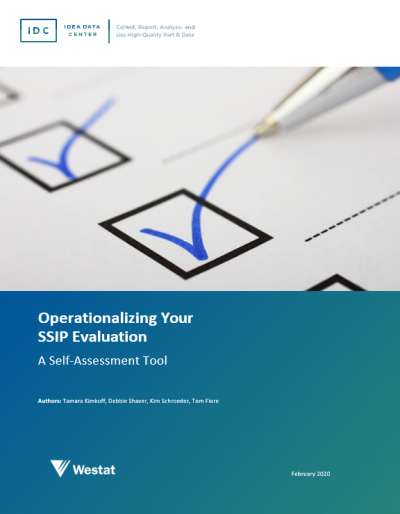
Resource Library
Guides. Briefs. Toolkits. Quick reference information. IDC and its partners created these data quality resources to help states better prepare to address their existing or emerging IDEA data quality needs. Use our search and filtering tools to navigate the library.
Resources 1 - 7 of 14
Format: Guides and Briefs
Measuring Significant Discrepancy: An Indicator B4 Technical Assistance GuideThe TA guide describes the methods a state might use to appropriately determine which of its districts has a significant discrepancy (including a significant discrepancy by race or ethnicity) in the rates of out-of-school suspensions and expulsions totaling greater than 10 days for children with disabilities.
Format: Guides and Briefs
Methods for Assessing Racial/Ethnic Disproportionality in Special EducationThis TA guide addresses the more common methods for calculating racial/ethnic disproportionality in special education. IDC revised the guide, which the Data Accountability Center (DAC) originally published in October 2011, because of a change in SPP/APR Indicators 9 and 10 to remove underrepresentation from the measure.
Format: Guides and Briefs
Considerations for Making Changes to SIMR Baseline and TargetsThis white paper focuses on considerations that could lead Part C or Part B state agencies to propose a change in their SIMR baselines or targets. It defines baselines and targets in the context of SSIP, illustrates the importance of baselines and targets, and provides reasons for a state to propose changing its baselines or targets.
Format: Guides and Briefs
Using a Theory of Action to Develop Performance Indicators to Measure Progress Toward a SiMRThis white paper focuses on the relationship between SSIP Phases I and II by demonstrating how the theory of action can be used to develop the SSIP evaluation plan and performance indicators that measure progress toward the SIMR.
Format: Guides and Briefs
Operationalizing Your SSIP Evaluation: A Self-Assessment ToolThe purpose of this tool is to lead those within a state responsible for implementing their SSIP evaluation through the process of operationalizing their SSIP evaluation plan in tandem with implementation efforts. State staff can use this interactive self-assessment to gauge their team’s progress on key components necessary for fully executing their SSIP evaluation plan and to identify action steps needed to realize the greatest benefit from their evaluation efforts.
Format: Guides and Briefs
The Assessment Data Journey: Are We There Yet?Data for Part B Indicator 3 follow a long and complicated process that begins when a student is registered as a test taker in a state assessment system and ends with public reporting via the SPP/APR. Multiple factors are involved in this process, and regular and ongoing communication and collaboration among the various people involved can make this process easier. This suite of four resources can help states with the work. The interactive infographic provides general information about the process for a typical state.
Format: Guides and Briefs
FFY 2020–25 Part B SPP/APR Changes at a GlanceThe FFY 2020–25 Part B SPP/APR Changes at a Glance resource is a quick overview for tracking updates to indicators in the new FFY 2020–25 SPP/APR package. For each of the 17 SPP/APR indicators, the table denotes whether there will be no changes, minor changes and/or clarifications, changes to response rates and representativeness, changes to data sources, and new components.








